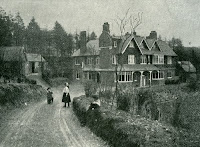How does Arthur Conan Doyle live on?
I've just posted a link to an article from the Telegraph
that was posted in May of this year. It can be seen on my scoop.it page. It
concerns the future of Undershaw which, as my regular readers know, is
something I go on about rather a lot.
In keeping with modern custom, there were a large number of
reader comments appended to the bottom of said article. As per usual, a lot
more chaff than wheat was to be found but one comment stood out for me.
The poster, who was clearly against the idea of saving the house,
remarked that we don’t need a house to remember Conan Doyle as he lives on
through his works.
A nice sentiment but does he really? The name lives on yes
but is that the same as the author living on?
One of the reasons Conan Doyle sought to kill off Holmes was
that he found Holmes to be an obstacle to his career perhaps even to his life
(i.e. the living of it). Holmes had become so real to the readers of The Strand Magazine that their demand
for more stories prevented his creator moving on to other things.
The upshot was that Conan Doyle the man was eclipsed by his
own creation who was deemed more important by the general public.
This state of affairs is as true now as it was then. There
are people out there who know every last thing about Sherlock Holmes but know
next to nothing about his creator. If this is the definition of an author
living on through his work then I question its accuracy. In reality this is the
character living on, not the author.
Over time authors start to become almost mythical, their
works increasingly (and inevitably) read by people born long after they themselves died. Their
names are known or at least dimly recognized but beyond that people know little,
if anything, about them. A good way to keep these authors, to a certain
extent, rooted on earth is to preserve something of the physical world they
lived in. People might argue that Conan Doyle has been the subject of many
biographies (I know, I've written two) and that therefore his life is well
documented but a biography is, ultimately, just a factual story and, as time
passes and the world moves on, it becomes as impossible to prove it to be true
as the latest Harry Potter (perhaps the only modern creation to come close to
eclipsing his creator).
This is where physical evidence comes in. Charles
Dickens’ birthplace in Portsmouth and his London
Undershaw represents
a place where, over ten years, he created much that we still enjoy today. The
house he designed and in which he walked, ate, slept and wrote will, when
combined with documentary and photographic evidence, allow him to truly live
on. People will then be able to see him as a human being and not just as the
man who gave us Sherlock Holmes.
For more information on Arthur Conan Doyle and his time at Undershaw please refer to my book, An Entirely New Country which is available through all good bookstores including Amazon USA, Amazon UK, Classic Specialities, and in all electronic formats including iTunes, Kobo, Nook and Kindle .
The Norwood Author is available from all good bookstores, in many formats
worldwide including Waterstones UK, Amazon UK, Amazon USA, Barnes and Noble,
Amazon Kindle, iBooks for the iPad/iPhone, Kobo Books, Nook.
Close to Holmes is available from all good bookstores, in many formats
worldwide including Amazon USA, Barnes and Noble, Amazon UK, Waterstones UK, Amazon Kindle, Kobo, Nook and iBooks for the iPad/iPhone.
Eliminate the Impossible is available from all good bookstores, in many formats worldwide including Amazon USA, Barnes and Noble, Amazon UK, Waterstones UK, Amazon Kindle, Kobo, Nook and iBooks for the iPad/iPhone.





Comments
Post a Comment